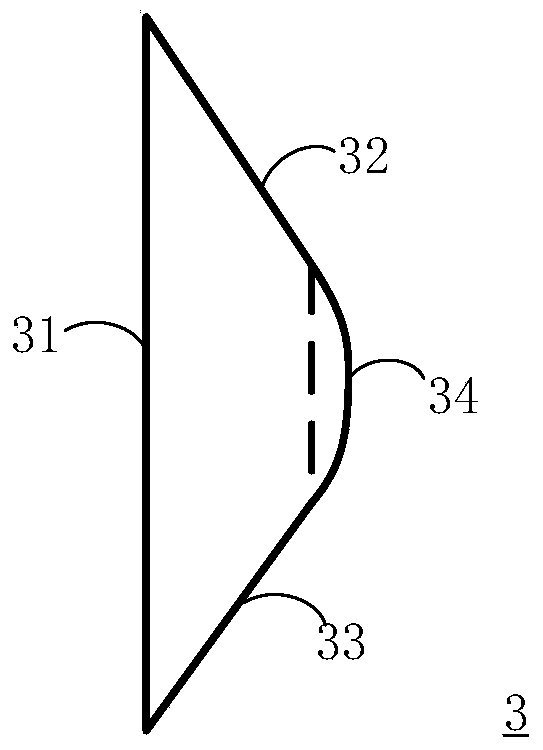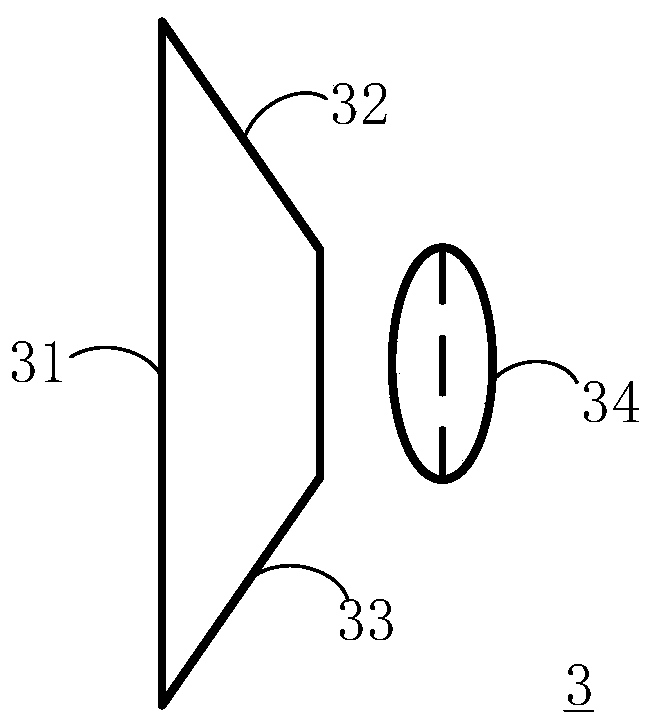Compound lens, and encodable single-frame imaging device and method
A compound lens and imaging device technology, which is applied to lenses, optics, instruments, etc., can solve the problems of diffraction efficiency and energy loss, limited working frequency bandwidth, reduced imaging field of view, etc., and achieves improved optical path stability, simple and fast recording. with reproduction, high-resolution effects
- Summary
- Abstract
- Description
- Claims
- Application Information
AI Technical Summary
Problems solved by technology
Method used
Image
Examples
Embodiment 1
[0060] See figure 1 , figure 1 It is a schematic structural diagram of a compound lens provided by an embodiment of the present invention. The composite lens 3 is modified on the basis of a prism, and includes a parallel light incident surface 31 , a first plane wave exit surface 32 , a second plane wave exit surface 33 and a spherical wave exit surface 34 .
[0061] Among them, the spherical wave exit surface 34 is in the shape of a lens, preferably in the shape of a convex lens.
[0062] The parallel light incident surface 31 , the first plane wave exit surface 32 , and the second plane wave exit surface 33 are all planar. Parallel light incident surface 31 is arranged opposite to spherical wave exit surface 34, and the width of parallel light incident surface 31 is greater than the width of spherical wave exit surface 34, and the width of preferred parallel light incident surface 31 is 3 times of the width of spherical wave exit surface 34. times. The first plane wave e...
Embodiment 2
[0070] See image 3 , image 3 It is a schematic structural diagram of a Fresnel incoherent holography-based encodable single-frame imaging device provided by an embodiment of the present invention. The imaging device includes: a light source 1 , a collimator lens 2 , a composite lens 3 and an optical signal receiver 4 .
[0071] The light source 1 emits incoherent light. The objects O, E, and I are placed on the incoherent light path, and the objects O, E, and I receive the incoherent light and emit the outgoing light. The collimating lens 2 is arranged on the optical path of the outgoing light, and is used for adjusting the outgoing light to be parallel light or approximately parallel light.
[0072] Specifically, the light source 1 can directly illuminate the objects O, E, and I. For example, when the objects O, E, and I are transparent, the incoherent light from the light source 1 can pass through the objects O, E, and I. to propagate, such as image 3 shown. The lig...
Embodiment 3
[0080] On the basis of the second embodiment, this embodiment takes the composite lens 3 as an example of a processed isosceles trapezoidal prism to describe the relationship between the parameters of the composite lens 3 and the parameters of the optical signal receiver 4 .
[0081] See Figure 7 , Figure 7 It is a schematic diagram of parameters of a compound lens and an optical signal receiver provided by an embodiment of the present invention.
[0082] Figure 7 Among them, a is the upper base of the compound lens 3, that is, the width of the spherical wave exit surface 34, and b is the lower base of the compound lens 3, that is, the width of the parallel light incident surface 31, and a and b satisfy b=3a, and h is the compound lens The height of 3 (the distance from the bottom edge to the lowest point of the spherical wave exit surface), α is the angle at which the plane wave beam exits, n is the refractive index of the compound lens, n 0 =1 is the refractive index o...
PUM
 Login to View More
Login to View More Abstract
Description
Claims
Application Information
 Login to View More
Login to View More - R&D
- Intellectual Property
- Life Sciences
- Materials
- Tech Scout
- Unparalleled Data Quality
- Higher Quality Content
- 60% Fewer Hallucinations
Browse by: Latest US Patents, China's latest patents, Technical Efficacy Thesaurus, Application Domain, Technology Topic, Popular Technical Reports.
© 2025 PatSnap. All rights reserved.Legal|Privacy policy|Modern Slavery Act Transparency Statement|Sitemap|About US| Contact US: help@patsnap.com



